Marijuana
(Weed, Cannabis, Pot, Grass, Ganja, Dope)
TrippyWiki score: 7.3/10
TABLE OF CONTENTS
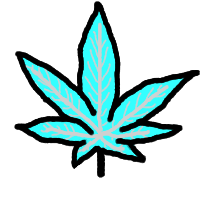
Introduction
Marijuana is the most popular psychoactive plant. Because of its safety and potential benefits, the plant is becoming legal all around the world and the stigma around it is soon going to disappear.
Long-term benefits & side effects
Many of the benefits will only occur if you follow the tips below.
Most (if not all) of the side effects are preventable and they will not happen if you follow the Safety checklist.
Weed…
Smoking marijuana doesn’t have a significant effect on longevity. Overall, smoking marijuana appears to be neutral for your physical health while eating it is slightly beneficial for preventing cancer.
Why choose marijuana over other psychedelics?
Marijuana…
How to take marijuana
Strains
There are over 700 unique strains, most of which are hybrids and their effects are somewhere in between Indica and Sativa.
Indica causes a strong “body high” that will make you sleepy or relaxed. A Sativa high is known to be more energizing and uplifting.
Every strain has a different THC and CBD content. On average, the weed that’s being sold on the street has 17% THC but one strain may contain below 1% while another can have over 30% THC.
Each of the 700+ strains also has its unique effects and benefits.
Smoking vs. Eating Weed
Cannabis can either be smoked or taken orally. You could also use it topically but topical marijuana doesn’t get you high.
The method you choose will have a significant impact on the duration of the high, as well as the effects and the intensity.
While the effects of smoked cannabis kick in almost instantly and completely disappear within 3-4 hours, eating cannabis should give you a 4-10 hour experience.
Not only will edibles last longer but the effects will also be more intense.
Eating marijuana is also believed to be slightly better for your health than smoking marijuana.
The downside to taking weed orally is that it takes 1-2 hours to notice the full effects, meaning that you might be tempted to eat more than you should.
If you are taking marijuana to treat seizures or extreme pain, smoking is a way to go because the effects will occur faster.
Smoking creates a euphoric head-high while edibles mainly cause a body-high.
How to smoke weed
There are dozens of ways to smoke weed, the 3 most common of them are using a pipe, a bong, and rolling out a joint.
All of these methods will lead to similar effects but different amounts of THC will be lost. If you use a vaporizer, you will be able to inhale around 40% more THC than with other methods.
You also want to find a method that is comfortable for you. For most people, using a bong is the most pleasant way to smoke weed. An additional benefit of going this route is that you will inhale fewer potentially carcinogenic compounds.
If you don’t have an access to a vaporizer or a high-quality bong, using a glass pipe seems to be the best option.
Unless you love rolling a joint, it is one of the worst options for multiple reasons:
1) The paper typically contains carcinogens
2) A lot of THC will be lost
3) It takes a lot of time to roll a joint
4) You will have to grind your cannabis before you roll it
After you inhale the drug, you do not have to hold it in. Cannabinoids get absorbed by your lung tissue almost instantly.
Taking weed orally
Edible marijuana can be sold in oils, tinctures, chewing gums, pills, drinks, cannabutter, and edibles.
This is the easiest way to prepare cannabutter that you can either eat directly or use for baking edibles:
1) Fill a pot with water and bring it to a boil. Once the water starts boiling, turn the heat down to a very slow boil.
2) Add 1-2 oz of weed and 1lb (0.45 kg) of coconut oil or butter.
3) Let the mixture slow boil for forty minutes. The mixture will turn green.
4) Take it off the heat.
5) Strien out the boiled marijuana residue and toss it.
6) Let it cool for twenty minutes before putting it in the fridge.
7) Leave in the fridge for two to three hours until it cools. The butter/coconut oil will rise to the top and harden.
8) Take the green pot butter/oil and use it for your marijuana baking needs. You can also eat it raw.
Remember that edibles can take a long time to kick in. Resist the urge to take more if you don’t notice any effects after a while.
Dosage
How much marijuana you should take depends on many factors, including:
So the numbers below may be different for you. The only way to find out the best dose is by experimenting with different doses yourself.
Oral Dosage
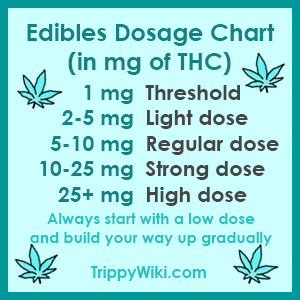
The mg doses above are displayed for THC. Each strain has a different THC content and the average of THC in weed is 17%.
Since the dosage varies so dramatically from person to person, there is no way to find out what the best dose for you is without trying weed.
To find the right dose for you, start low and build your way up gradually.
Smoked Dosage
When it comes to smoking, it is even more difficult to find out the right dose for you.
Furthermore, how much THC you will absorb depends on your smoking technique and what device you use.
For example, if you use a joint, around 60% of THC will be lost. If you use a bong instead, the number goes down to 55%. With a vaporizer, only 45% of THC will be lost.
Either way, it is best to start with 0.1 – 0.2 grams of weed and build your way up gradually.
Safety checklist
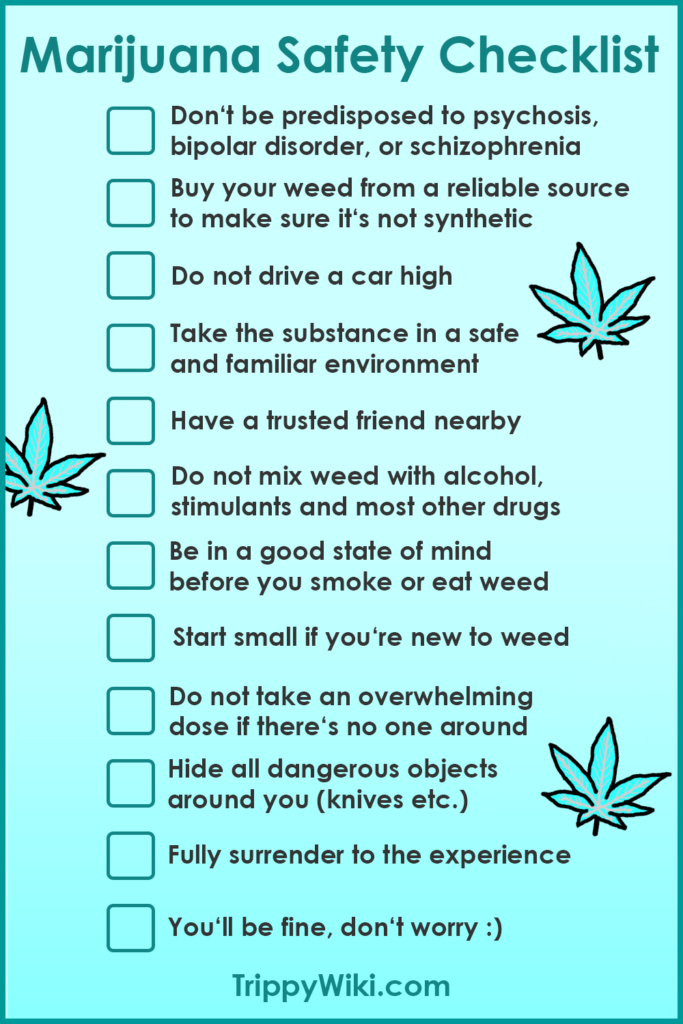
Maximize the benefits
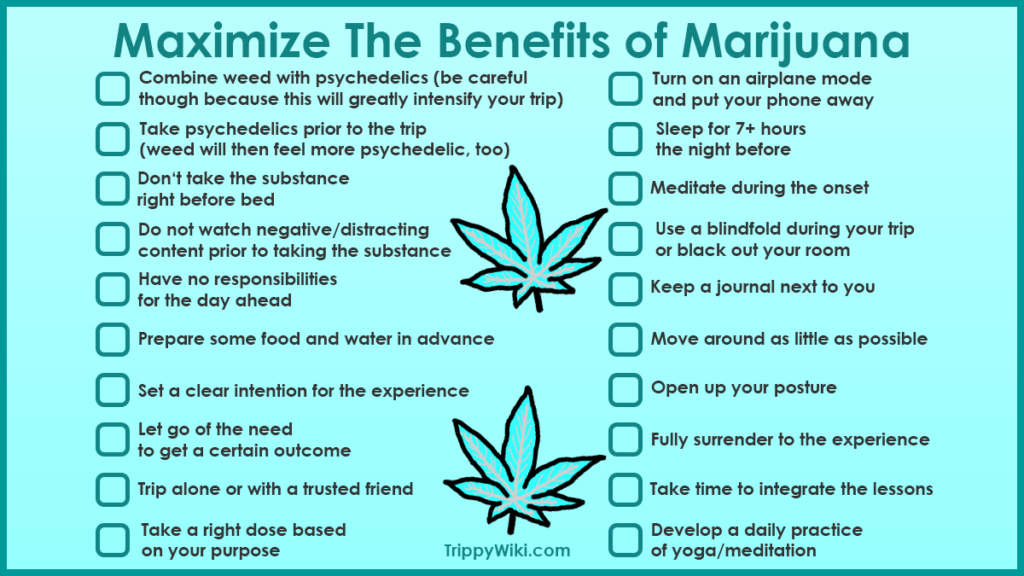
Keep in mind that if your goal is psychological or spiritual growth, integration is even more important than the trip itself. Taking weed and other psychedelics would be almost useless if you didn’t retain any lessons in your day-to-day life.
What will help you the most is contemplating about the experience – be it by journaling, thinking about the trip, or sharing your memories with a trusted friend.
Distracting thoughts can get in the way, which is why you want to spend the day after your trip without TV, social media, and other distractions.
If you can, spend time in silence and solitude. Meditate, go for a walk, contemplate the experience.
Duration
Smoked Duration
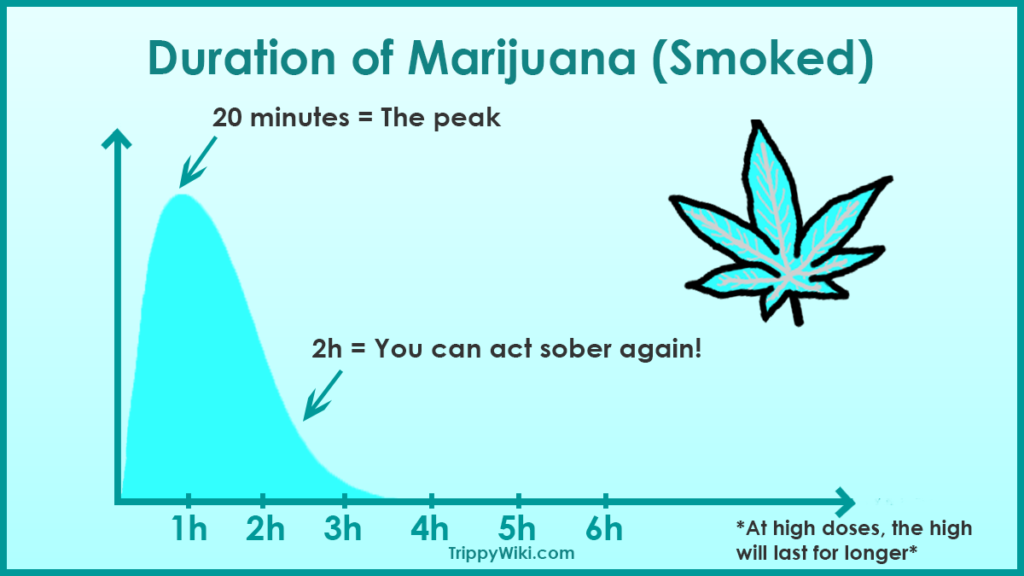
Onset = 0-10 minutes
Come up = 5-10 minutes
Peak = 15-30 minutes
Come down = 45-180 minutes
Edible Marijuana Duration
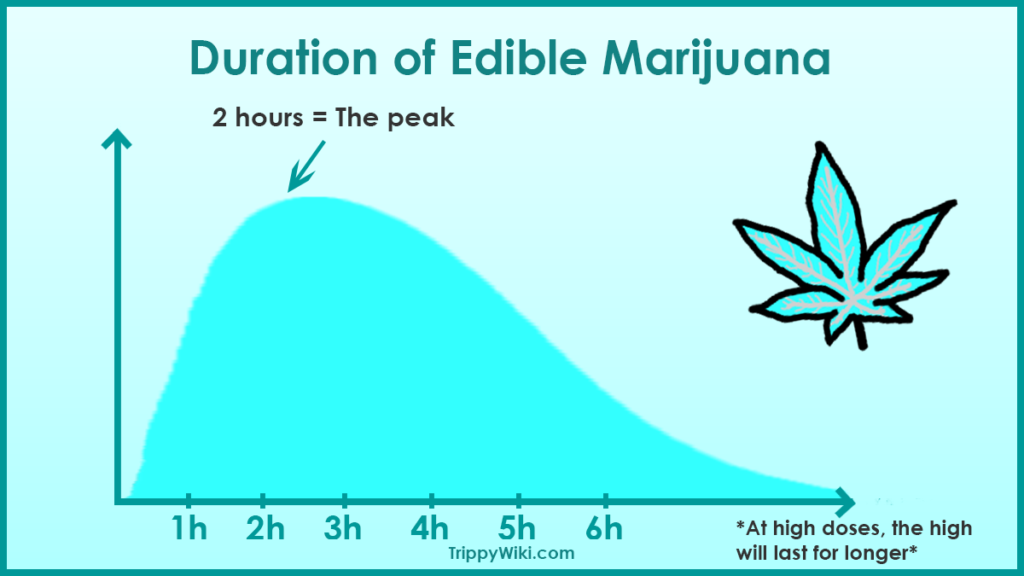
Onset = 30-120 minutes
Come up = 30-60 minutes
Peak = 2-5 hours
Come down = 1-2 hours
What does marijuana feel like?
Common short-term effects include:
Euphoria
Increased creativity and open-mindedness
Mindfulness, being present
Relaxation
Stress reduction
Pleasant body feel
Increase in body/mind connection
Higher capability for love and compassion
Pain relief
Seeing life from a different perspective
Appreciating small things
Higher energy
Increased awareness
Stamina enhancement
Feeling your emotions more intensely
Memory suppression
Inability to sleep
Tiredness
Increased food appetite
Time distortion
Visual effects (enhanced colors, seeing patterns, distortions, …)
Facial tension
Coughing
Mouth dryness
Dizziness
Getting stuck in a thought loop
Confusion
Nausea
Headache
Inability to focus
Increased body temperature
Increased heart rate
Worse thermoregulation
Anxiety, paranoia
Vulnerability
The higher dose you take, the more intense these effects will be.
Weed affects each individual differently and no two strains are the same. Therefore, there is virtually no way to know what your experience will feel like.
The only way to know what cannabis feels like is to take cannabis.
Weed will most likely give you a pleasant experience. Bad trips can happen but you can prevent them by following the tips below.
Bad trips
Bad trips mostly happen because people take the substance irresponsibly. If you use weed the right way, there is virtually no chance you’ll get a bad trip.
In case you still do, that’s good! A “bad” trip isn’t bad, it can actually be the most healing and insightful moment of your life!
During a “bad” trip, negative emotions are coming up from your subconscious mind. They have always been there whether you are aware of it or not. They have been damaging your life and a difficult trip is an opportunity to process these traumas and unpleasant feelings and let go of them.
The more painful the experience, the more you can heal.
So instead of calling bad trips bad, call them challenging.
If you understand that bad trips are awesome in the long run, not only will you feel more comfortable diving into these challenging states, it will actually excite you!
Why they happen
The most common reasons for getting a bad trip are:
How to cope with a bad trip
How to end a bad trip
In case you are not ready to face your inner demons yet, there are a few ways to end a bad trip.
One possible way is to put on music that is familiar to you. Another way is to switch up your location and move from one place to another. This can completely change your train of thought.
In case the trip becomes extremely challenging and there is no one around you to keep you safe, consider ending your trip with a trip killer.
Using a trip killer usually is not the best idea because the bad emotions will stay unresolved and you will get little to no benefits from the experience. With that said, using a trip killer is smarter than harming yourself.
The 2 best options that you have for ending a bad trip are Phenibut and benzodiazepines.
Phenibut is generally safer. The downside is that it can take hours to kick in.
So to end a trip, use benzodiazepines but only do this if you completely have to.
Benzodiazepines will not completely stop your trip but they will definitely calm you down.
Cannabis withdrawal
Contrary to popular belief, marijuana can be both psychologically and physically addictive.
Cannabis withdrawal mostly happens to people who have been smoking weed on regular basis for multiple months or years.
When users stop using weed, they often go through a period of anxiety, irritability, decreased appetite, sleep problems, and other unpleasant symptoms.
The withdrawal typically peaks 2-3 days after a user stops smoking and lasts for 1-2 weeks. In rare cases, the withdrawal can last for multiple months.
One way to lower the chance of a withdrawal is to test your marijuana to make sure it isn’t sprayed with synthetic cannabinoids. Even though the plant itself can be addictive, synthetic cannabinoids are a lot more addictive. On top of that, they are extremely common.
Interactions
Microdosing
Microdosing marijuana is becoming more and more popular.
Some people take tiny doses of THC to lower anxiety and depression, others do so to become more creative or increase their stamina.
Even people dealing with severe conditions, such as Parkinson’s, will most likely benefit from taking tiny doses of weed.
Microdosing with cannabis seems extremely safe in the long term. If you don’t notice any benefits, you can always stop taking them.
How to microdose
Users usually microdose with 1-2.5 mg of oral THC daily.
How much you will need depends on multiple factors and the only way to find out what dose works for you is to experiment.
In some countries, you can legally buy cannabis oil or capsules that contain a microdose of THC and are extremely easy to dose.
If you cannot buy these legally, all you have to do is to create a cannabutter (following the recipe above) and take the desired dose daily.
History of Marijuana
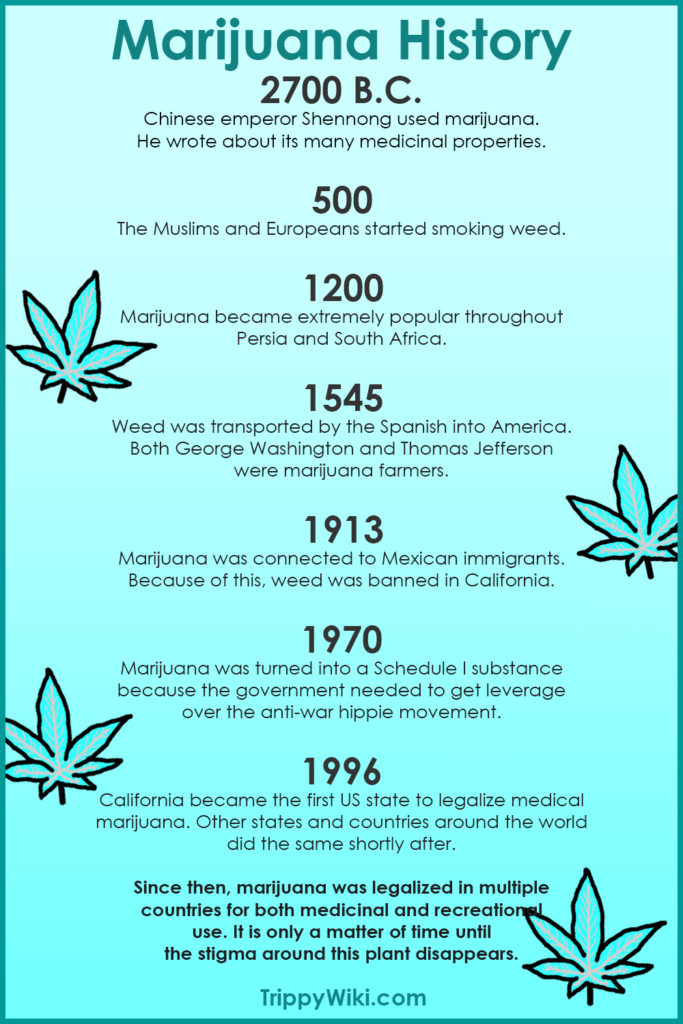
Legality
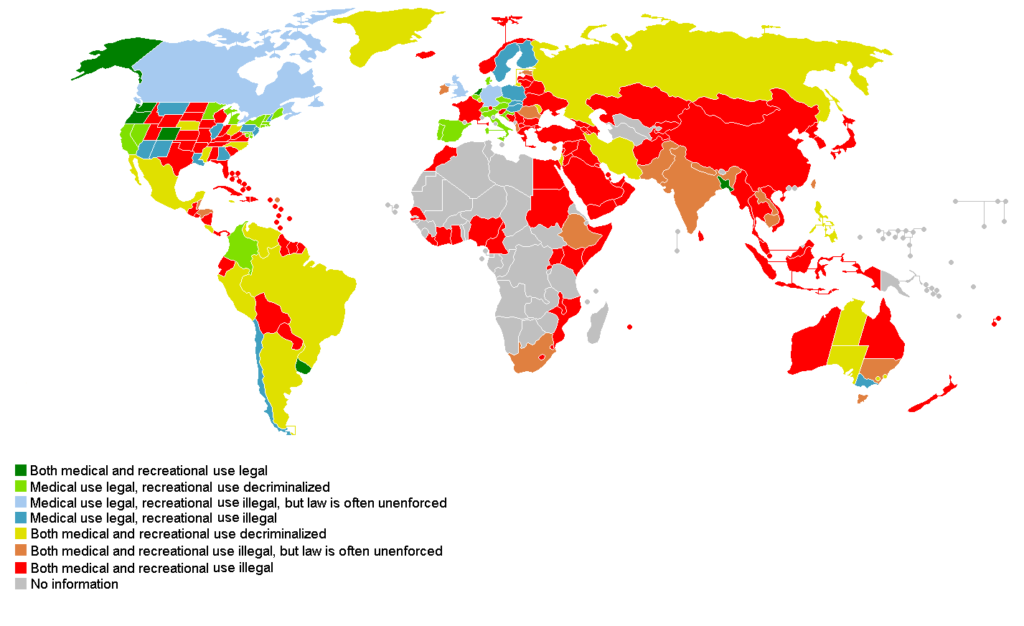
Marijuana is quickly becoming legal in most countries of the world so at the time you’re reading this article, the map may already be outdated.
In the countries where marijuana is legal, there is almost always an age limit, usually 18 or 21 years of age.
Where to get marijuana
These are the ways you can get your hands on weed:
Synthetic cannabinoids
If you buy weed from a random drug dealer, there is a high chance he will sell you a plant that has been sprayed with synthetic cannabinoids.
In fact, one of the most influential German weed suppliers claims that 90% of marijuana sold on the street in Germany is sprayed with these chemicals. This may not be the case for your country but the chance is still extremely high.
Synthetic cannabinoids include:
4F-ADB
5C-AKB48
5CL-ADB-A (MDMB-4en-PINACA)
5F-AB-PINACA
5F-ADB
5F-AKB48 (5F-APINACA)
5F-PB-22
AB-CHMINACA
AB-FUBINACA
AB-PINACA
AKB48 (APINACA)
AM-2201
APICA (2NE1)
BB-22
EG-018
JWH-018
JWH-073
MAM-2201
MMB-CHMINACA
NM-2201
STS-135
THJ-018
THJ-2201
UR-144
… and 400+ more
Most of these chemicals were created to mimic the effects of THC.
Unlike cannabis, synthetic cannabinoids aren’t always physically safe. In fact, most of them would cause you long-term health problems and some can even kill you.
The safest synthetic cannabinoids that you can still buy legally in most countries are THJ-018 and NM-2201. Even these, however, have multiple potential side effects.
It is possible that most of the reported side effects of cannabis aren’t caused by cannabis itself but rather synthetic cannabinoids.
If you still want to try synthetic cannabinoids, never buy them from a random drug dealer! You cannot know what you are getting that way.
Instead, buy the substance from a research chemical company like Chemical Collective. Only do it, however, if you cannot get your hands on real marijuana and you have a good reason to get high.
FAQ
“Herb is the healing of a nation, alcohol is the destruction.“
– Bob Marley
You may also like:
Thank you for taking psychedelics responsibly, immature psychonauts are the last thing the psychedelic movement needs.
And thank you for being a part of this renaissance. Together, we can change the world!
